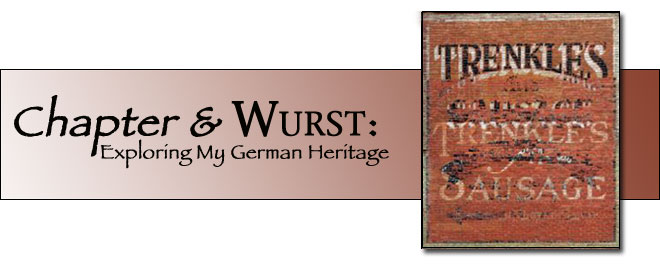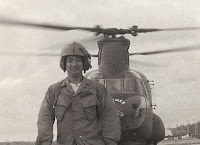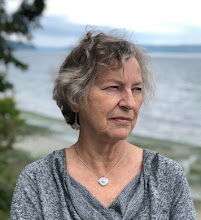Above all else, what does a family researcher hope to unearth while sorting through the scraps and remnants of an ancestor’s life? Well, for me it’s a fascinating story that brings that person, family, or times alive in vivid detail. I always hold out hope that I’ll find a snippet that reveals their personality or trials or achievements. Then I’ll keep searching until I can enlarge the snippet into a full-blown tale to share with my children and grandchildren. Sometimes the newspaper article or document is shocking or unbelievable. However, in the case of the Holz Family Black Sheep, the events were merely sad and unfortunate.
Charles Alexander Terre was the first and only son in a family of five. His father, Carl H. (or Charles), was born in Bettingen, Rheinland, Prussia in 1842 and shortly after immigrating to Dubuque, Iowa in 1871, he met and married Susanna S. Holz, my great, great aunt, in 1872 when she was twenty years old. One year later, a daughter, Mary Barbara, was born but must not have survived because shortly after their second daughter, Mathilda Rose, was born in 1875, the family of only three migrated west to San Francisco. There, in December, 1878, Charles Alexander was born. The four appear in the 1880 census. Carl, the father, is working as a dry goods clerk, which tells me ambition may not have been the family’s reason for leaving Dubuque where Susanna’s large family prospered and were available for support. In later years, Carl was employed as a cook and saloon keeper in several different California locations. His son is never listed in the same household as his father, except in 1880 when he was two years old.
By 1882, Carl and his wife must have separated, as Susanna gave birth to a third daughter, Kathryn, in Dubuque and this time, her infant’s baptismal sponsors did not include members from Carl’s family. In the 1900 census, Charles Terre, age 58 and a servant, states he is divorced.
I continued to search for the family and discovered Charles Alexander listed in the 1910 census as a barber in Folsom prison, a strange place to find employment…but wait! He’s listed as a prisoner! All sorts of questions crossed my mind…chief among them: what crime did he commit? It must have been huge.
Folsom Prison was opened in 1880 to house California’s “incorrigibles, repeat offenders, and those serving long sentences”. It’s long been known for its harsh conditions and was thought of as the “end of the line”. Inmates spent most of their time in dark, stone cells behind solid boiler plate doors with only a six-inch eye slot. There was no heating or plumbing in the cells and only an oil lamp for light. The prisoners wore black and white striped pants and whatever jackets or shirts they owned when they were sentenced. Up until 1912, the year that corporal punishment was abolished, infractions of the prison rules meant straightjackets or being tied up by their thumbs and hands.
Surely, the black sheep in my Holz family had been a hardened criminal. Only a very horrible crime deserved a trip to Folsom.
Then, during a research trip to Salt Lake City, I found an index on the shelf--Folsom Prison: List of Convicts. It revealed the names and numbers of the prisoners from the year the prison opened in 1880 until 1942. On page two, Charles was listed twice! Definitely one of the incorrigibles.
Now that I knew Charles’ assigned numbers, I attempted to find out how to obtain his prison or sentencing records. I hit a dead end until I read that California inmate records were held in the state archives and might even include photographs of the men. I sent for and soon received a packet with some of the answers to my many questions, along with mug shots taken on his two sentencing dates in 1910 and 1915. His questioning and testimony revealed the sad tale of a harmless, luckless petty thief.
The first time he was arrested, the bar keeper and two policemen surprised him in the act of reaching into the pocket of a man sleeping it off in the back room of the Columbia Café in Sacramento. Charles had been drinking heavily or, he claimed, he never would have done such a terrible thing. He was made to put the money back and was later sentenced to two years in prison for grand larceny. The judge, J.W. Hughes, did not believe his feeble attempt to explain the circumstances nor did he accept Charles’ picture of his life as a gainfully employed waiter in some of the best restaurants in San Francisco and Sacramento (even though Charles was able to name each owner and establishment, as well as the length of time he was a waiter at each. He said he worked twice for a famous French restaurant during a recent fair.) Nor did the judge believe Charles’ description of his happy life as a married man with a wife and three sons (whom, he claimed, were visiting the wife’s family in Tacoma for six months). I tried without success to locate any record of a wife and children. He didn’t correct the judge when he mentioned Charles’ two sons—not three. Charles’ fib must have been detected—certainly suspected. The amount he attempted to steal? A mere $5.75. Prisoner Number 7680 was sentenced on 29 September 1910 and finally released on 29 May 1912.
Three years later, on 16 October 1915, Charles—now Prisoner Number 9767--was arrested a second time and sentenced to twelve long years for burglary in the 1st degree. In 1917, he requested a commutation for having received an “excessive sentence”. He claimed that although the bar keeper saw him run out the back door of the saloon, nothing was taken and no damage was done. The appeal was written on stationary from the California Highway Commission and the day labor camp at Camptonville, Yuba County. Beginning in 1916, the state opened three convict camps and used prison labor for road construction. After 1923, if the inmates worked hard they could pay off the initial expense of their supplies and transportation after three or four months and from then on, their net earnings of 50 to 75 cents a day would be set aside for them to receive upon release. In addition, for every two days a prisoner worked, he could erase one day from his sentence. Charles probably did not receive the benefit of this compensation since he was released on 16 June 1923. He may have been discharged after serving only eight years for good behavior or perhaps he was ill. He died four years later at the age of 49 in the home shared by his two widowed sisters, Tillie Rose and Kate. He showed up on their doorstep four days before he died.
Why did Charles’ life turn out as it did? From the few records I’ve found, it’s evident that he lived an itinerant life…moving frequently and working sporadically as a waiter and a barber. He is found in California’s voter records as a Republican but each entry lists a different address. He took the time to register to vote and his letter asking for early release is well written in careful penmanship. No doubt, he was educated in San Francisco schools. Certainly alcoholism was a factor, as it often is with those in the restaurant business. This may have been a cause, as well, for his parents’ early divorce and his father’s frequent moves and job changes. Also, he was born to a family that did not choose to surround themselves with close family support. Charles’ mother and father both are listed alone in several census enumerations. Only his two sisters remained in place in Oakland for over forty years.
In August, 1902, when Susanna’s father, Peter Holz, drew up his last will and testament, he left a share of his property to her. When his obituary was published in 1904, she was still in California and when his will was settled in late 1904, Susanna Smith (nee Holz) of Colton, California was listed as one of his legatees. I assumed she had remarried but have not discovered records to prove this. By 1910, she is back in Dubuque, living alone and working as a private duty nurse for a local family. She is listed in Dubuque’s city directories of 1923 and 1927 as Susan Smith. However, in her brother, John Holz’s, obituary, Susan Terry of California is among the list of his survivors. I mention this to show that Charles’ mother was alive in 1927 when he died. Did they write to each other? Did she even know of his imprisonment or death? Did he keep in touch with his father? His sisters? Probably not since, it seems, he’d much rather sit alone in a saloon after work, losing himself in drink.
These family snippets were expanded into a sad tale of solitary and luckless lives. It did not have the satisfying ending I had hoped for when I began my search for Charles Alexander Terre.
































